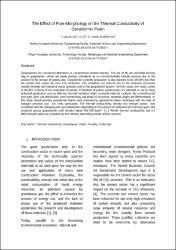The effect of pore morphology on the thermalconductıvıty of geopolymer foam
Özet
Geopolymers are considered alternative to conventional cement recently. The use of fly ash and blast furnace slag in geopolymer, which are waste product considered as an environmentally friendly product due to the solution to the storage of wastes also. Geopolymer concrete production is also reported to be 44-64% less than the cement that causes the most CO2 emissions. CO2 emissions are reduced due to the minimum processed natural minerals and industrial waste products used in the geopolymer system. For this reason, this study comes to the fore in terms of the evaluation of wastes. Production of porous geopolymers are potential in use in many industrial application such as filtering, thermal insulation, light structural material, catalysis. By controlling the pore type, pore size distribution, pore connectivity and shape of porosities, potential usages are differentiated. In this study closed porosity geopolymer foams were produced by geopolymerization technique with the help of hydogen peroxide and non ionic surfactants. The thermal conductivity, density and strength values was correlated with the changing pore size distribution depending on the amount of surfactant and foaming agent. We produced porous geopolymers with density values 450-500 kg/m3, 0.12 W/mK thermal conductivity and 2.1 MPa strength value was prepared by this method. Interesting results will be reported.



















